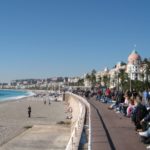To truly grasp the soul of this unique path on the Riviera, it is essential to witness the enchanting daily spectacle of sunrise and sunset. Depending on the seasons, it sets ablaze the sea, the city, or the hills. Only after experiencing this unforgettable moment can you feel the essence of this simply magical place, where the ethers of beauty and poetry hover.

The promenade has been sung about, praised, lauded, and extolled. Its history begins with an English pastor who decided to create a path by the sea between Paillon and Magnan. The Promenade would change its appearance several times, with villas giving way to buildings and luxury hotels. The clientele no longer contented themselves with the municipal casino or the promenade pier; they wanted an establishment that would meet their expectations—a cruise ship to satisfy their taste for excess.
The Palais de la Méditerranée would quickly become the emblematic building of the Promenade. Everything was planned in this building: gambling, dining, or enjoying shows. Its realization is the work of the most famous architects, sculptors, and artists, whether glassmakers or cabinetmakers. This palace of pleasure and refinement was one of the icons of this Promenade des Anglais, a jewel of beauty and luxury. The Jetée Promenade and the palaces of Ruhl and Negresco, pearls and diamonds of this Bay of Angels, echoes of the past, completed giving nobility and grandeur to this ribbon of asphalt stretching along the shore illuminated by the lights of the queen’s necklace. The clientele would thus wander, according to their whims, between the palaces and casinos, all cruise ships stranded on this God-blessed shore. Luxury still had meaning, a significance.
In the evening, the curtain would fall on this social scene where at times a firework would conclude the Veglione of the carnival or another event. It is an era, alas, gone by. Ruhl was demolished to make way for a horror of glass and steel. The Palais de la Méditerranée now only has its facade, and many villas have been destroyed to make way for buildings without style or soul. All that remains of this era is the Negresco, the only hotel still adhering to the notions of luxury and refinement. The Promenade has become a kind of highway; the tram project would have had the advantage of driving out cars and making this tram line the most beautiful in the world.
Can we dream of a future where the Promenade is returned to the pedestrians? To replace the cars, we could recreate carriages with horses and thus restore to this avenue a part of its nobility and grandeur. Dreaming and utopia are the privileges of noble souls, so let us dream.
T Jan.



